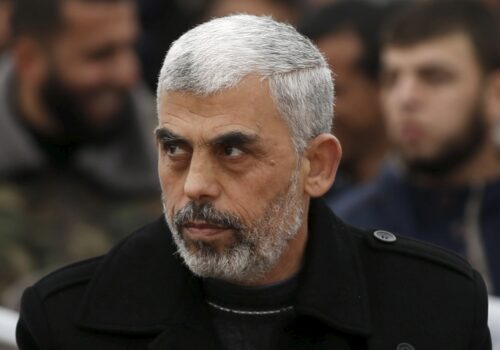
After Sinwar’s death, what’s next for Iran’s Axis of Resistance?

JUST IN
Three hundred and seventy-six days later, he is dead. Hamas leader Yahya Sinwar, the mastermind of last October’s terrorist attack on Israel, which set off a year of war in the Middle East, was killed by Israeli soldiers today in the Gaza Strip. Sinwar’s death follows Israel’s assassination of Hezbollah leader Hassan Nasrallah and ongoing campaign against both Hezbollah and Hamas, leaving Iran’s “Axis of Resistance” proxies in the region under severe strain. What should we expect now from Israel, Iran, and these groups? Our experts are on the case.
TODAY’S EXPERT REACTION BROUGHT TO YOU BY
- Ahmed F. Alkhatib (@afalkhatib): Resident senior fellow with the Scowcroft Middle East Security Initiative at the Atlantic Council’s Middle East Programs and analyst who grew up in Gaza City
- Jonathan Panikoff (@jpanikoff): Director of the Scowcroft Middle East Security Initiative and former US deputy national intelligence officer for the Near East
- Emily Milliken (@EmilyMPrzy): Associate director at the N7 Initiative in the Middle East Programs
For Hamas in Gaza, chaos and an opening
- Sinwar’s death provides possible “off-ramps” for the war in Gaza, Ahmed tells us. He predicts “chaos” within the group that gives Israel and its allies a “chance to exploit uncertainties and divisions” to gain the release of the remaining Israeli hostages and “a general stand-down and demobilization within Hamas.”
- Jonathan notes that a new Hamas leader, especially one from outside Gaza, “may be more inclined to finalize a deal than Sinwar was.” That means US President Joe Biden will have his best opportunity in months to “again push for a ceasefire” and Israeli Prime Minister Benjamin Netanyahu will face more political pressure to strike a hostage deal ”than at any point since the war began.”
- Ahmed says there are certain steps the United States, Israel, and Arab states can take now to hasten the group’s demise: “mass amnesty” for Hamas members who stop fighting, “financial rewards” to those who help recover hostages, and a commitment from Israel “to pull out of Gaza and avoid the reoccupation of the Strip in the immediate future” while opening up the Strip to “Arab, international, and Palestinian Authority figures” to stabilize the situation.
Subscribe to Fast Thinking email alerts
Sign up to receive rapid insight in your inbox from Atlantic Council experts on global events as they unfold.

-
-
This field is for validation purposes and should be left unchanged.
For Hezbollah in Lebanon, the fight continues
- For the past year, Hezbollah has tied its rocket attacks on Israel to the war in Gaza. But “Israel’s operations in Lebanon have already begun and are not likely to stop, no matter the result in Gaza,” Jonathan tells us, unless there’s a mega-deal that also includes Hezbollah moving its fighters away from the Israeli border, “allowing some 70,000 Israelis finally to return home.”
- There are divisions within Israeli political and military circles around the war in Gaza. Not so regarding the campaign against Hezbollah, Jonathan notes.
- “With air and ground operations already underway, the Israel Defense Forces (IDF) is likely to want to continue eliminating Hezbollah’s cache of its most lethal weapons, such as ballistic and cruise missiles,” Jonathan says.
For the Houthis in Yemen, new prominence and new risks
- The Yemen-based Houthis could rise in prominence after spending the last year disrupting global shipping by firing on vessels in the Red Sea, Emily says. “Tehran will likely prioritize providing the group with advanced weapons and weapon components to enable more accurate and devastating maritime operations and strikes on Israeli territory,” she tells us, with Iran perhaps working with Russia to provide the Houthis with anti-ship missiles.
- But increased prominence comes with increased risks that the group’s leader, Abdul Malik al-Houthi, could meet the same fate as Nasrallah and Sinwar (among many others who end up in Israel’s crosshairs). If the IDF targets senior Houthi leaders, Emily says, it “could degrade the group’s ability to operate, spur a leadership crisis, and widen the leadership vacuum within Iran’s network of allies and proxies.”
Further reading
Thu, Oct 17, 2024
Experts react: Yahya Sinwar is dead. Here’s what’s next for Hamas, Gaza, Israel, and the Middle East.
New Atlanticist By Atlantic Council experts
Israel confirmed on Thursday that it had killed the Hamas leader. Atlantic Council experts share their insights on what this means for the immediate conflict and beyond.
Fri, Oct 4, 2024
One year after Hamas’s October 7 terrorist attacks, here’s how the region has changed
MENASource By Atlantic Council experts
One year on, the Gaza War remains unresolved and the potential for war across the region is becoming more likely. Atlantic Council experts take on questions about the war’s impact—and its future.
Wed, Oct 9, 2024
Israel’s dramatic gains on Iran present a historic chance—and enormous risks
Inflection Points By Frederick Kempe
Israel may now have “escalation dominance” over Iran and its proxies, but a new bipartisan Atlantic Council report underscores why both Israel and the United States need a strong and long-term strategy for dealing with Tehran.
Image: A billboard with a picture of newly appointed Hamas leader Yahya Sinwar is displayed on a building in a street in Tehran, Iran, August 12, 2024. Majid Asgaripour/WANA (West Asia News Agency) via REUTERS ATTENTION EDITORS – THIS PICTURE WAS PROVIDED BY A THIRD PARTY




